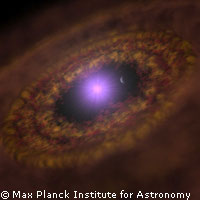Born from dust and gas
Scientists of the Max Planck Institute for Astronomy (MPIA) have discovered a planet that orbits TW Hydrae, a young star which is still surrounded by a circumstellar disk. The planet, which will be called TW Hydrae b after its mother star, is the youngest planet currently known to the scientific world. 'With the discovery of the first planet orbiting another Sun-like star, our understanding of planet formation has experienced a renaissance,' the astronomers explain in an article published in the current issue of Nature. The discovery is particularly significant as it demonstrates that planets can form within ten million years of the formation of the central star. The planet was detected using the radial velocity (RV) technique. Until now, this technique had not discovered plants around a star younger than 100 million years. TW Hydrae, however, is known to be no older than eight to ten million years. In addition, the Max Planck researchers have managed to directly link the development of the circumstellar disk to the process of planet formation for the first time, says Thomas Henning of the MPIA. The RV method is highly sensitive to giant planets on short-period orbits such as TW Hydrae b, which has ten times the mass of Jupiter, the largest planet of our solar system, and orbits the star with a period of 3.56 days. Close to a bright star, planets look like fireflies close to a flood light. As a result, little is known about the timescale of planet formation because it can only be observed indirectly; orbiting their mother star, planets tear at the star due to their gravitational field. Thus, the star will sometimes seem to draw slightly closer to Earth, while appearing to move further away at other times. In the first case, its light waves will be compressed into higher frequencies, resulting in a blue shift. In the second, they are stretched into lower frequencies, causing a red shift. Both shifts are results of the Doppler effect and help not only to detect a planet, but to determine the lower limit of its mass. 'When we discovered the variation in the radial velocity of TW Hydrae, we also found periodic changes that indicated the presence of a planetary companion and could not originate from star spots,' MPIA's Johny Setiawan recalls. Variation in RV caused by star spots occurs at irregular and shorter intervals. While 'the RV method still remains the most successful technique for detecting exoplanets', other methods are currently being developed by the MPIA and others, using direct imaging, measuring the apparent movement of a star through astrometry or the changes in a star's brightness when a planet passes in front of its central star (transit photometry).
Countries
Germany



